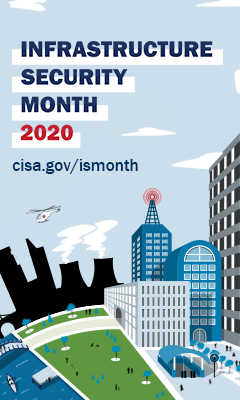Yesterday, November 1st, 2020, marked the first day of National Critical Infrastructure Security Month. Championed by the Cybersecurity and Infrastructure Security Agency (CISA), November is dedicated to celebrating and bringing awareness to the 16 sectors of critical infrastructure (CI), without which our nation would not function.
According to CISA, CI is defined as the “assets, systems, and networks, whether physical or virtual” which “are considered so vital to the United States that their incapacitation or destruction would have a debilitating effect on security, national economic security, national public health or safety, or any combination thereof”1.
“We often take it for granted that we can turn on the faucet and there’s clean water, or that we can flip on the light switch and there’s electricity,” said Dr. Brad Sims, President of Capitol Technology University. “We often think of critical infrastructure as operating behind the scenes. But if a power plant gets attacked and goes down, then electricity stops. If a water treatment plant gets attacked, then you don’t have clean drinking water.”
The 16 sectors of critical infrastructure are: Chemical; Commercial Facilities Sector; Communications; Critical Manufacturing; Dams; Defense Industrial Base; Emergency Services; Energy; Financial Services; Food and Agriculture; Government Facilities; Healthcare and Public; Health; Information Technology; Nuclear Reactors, Materials, and Waste; Transportation Systems; and Water and Wastewater Systems.
After what CISA dubbed a “Time of Transformation” following the wide-spread shift to remote work and learning caused by COVID-19 and the designation of the election processes as critical infrastructure, this month will focus on two themes: “The Security and Response during a Global Pandemic and the Future of Securing Critical Infrastructure".
Early sectors of Critical Infrastructure, before the term was even coined, mainly had to be prepared for physical threats such as a hijacking or mechanical malfunction of a train. With the advent and adoption of the internet, CI has become more vulnerable due to multi-pronged threats consisting of both physical and online threats including hacking, denial of service, and malware, to name a few.
The near omnipresent internet creates a new level of interference to CI. For instance, as discussed by Diane Janosek, the National Security Agency's Commandant and Training Director for the National Cryptologic School, in a webinar titled Aerospace: The Critical Domain of Space and Cyber Security, cyber threats to space security are rising. The United States’ dependence on space technologies such as satellites, which ranges from personal car GPSs to the government’s control of autonomous and unmanned systems including weapons, could have a devastating impact if those technologies are attacked.
Capitol Technology University has long recognized the impact of CI on our nation and the lives of people around the globe. This is why the university has not only celebrated National Critical Infrastructure Security Month since 2018, the year CISA was formed when President Trump signed into law the Cybersecurity and Infrastructure Security Agency Act of 2018, but has also created multiple degrees focused on Critical Infrastructure at every education level.
For instance, Capitol Tech offers a BS in Construction Management and Critical Infrastructure, an MS in Aviation Cybersecurity, and a PhD in Critical Infrastructure, among many others.
Click here for more information about Critical Infrastructure or click here to learn more about Critical Infrastructure at Capitol Tech and the university’s celebrations.
References
- CISA. (2020, October 21). Critical Infrastructure Sectors. Retrieved from https://www.cisa.gov/critical-infrastructure-sectors.



